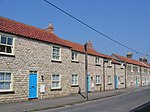Swinton, Ryedale
Civil parishes in North YorkshireNorth Yorkshire geography stubsUse British English from January 2019Villages in North Yorkshire
Swinton is a village and civil parish in North Yorkshire, England. It is about 2 miles (3.2 km) west of Malton on the B1257 road, and is on the edge of the Howardian Hills AONB to the immediate north. The village appears in the Domesday Book as 'Swintune' which is derived from 'pig farm'.The parish had 467 residents at the 2001 census, which had risen to 608 by the time of the 2011 census. By 2015, North Yorkshire County Council had estimated the population to have been 630.The village was part of the Ryedale district between 1974 and 2023. It is now administered by North Yorkshire Council.
Excerpt from the Wikipedia article Swinton, Ryedale (License: CC BY-SA 3.0, Authors).Swinton, Ryedale
Middle Street,
Geographical coordinates (GPS) Address Nearby Places Show on map
Geographical coordinates (GPS)
| Latitude | Longitude |
|---|---|
| N 54.14954 ° | E -0.83936 ° |
Address
Middle Street
Middle Street
YO17 6SS , Swinton
England, United Kingdom
Open on Google Maps








